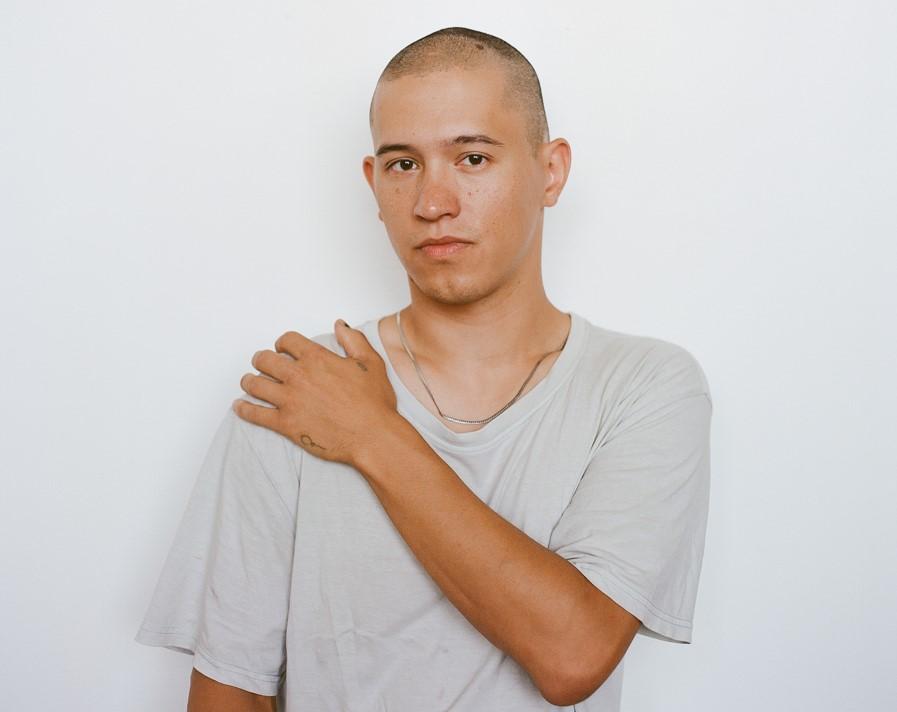
Portrait of Simon Fuh by Clea Christakos-gee
Summer last year artist Simon Fuh built a custom speaker stack, made one failed attempt, and then a successful one, moving the speakers out to the banks of Toronto’s urban ravine system for an all-night rave. The rave was to follow in the lineage of a series of studio parties he threw in his hometown, Regina, in 2019, and SUGARLOAF, a party he organized under the Bloor Viaduct in Toronto, with Pumice Raft in 2022. The night of the first attempt, following an infamous rainout, he and friends moved the speakers back to his shared studio in The PATH—an underground pedestrian walkway that links towers in Toronto’s financial district and various downtown tourist attractions—and instead, a dozen friends came by for a spontaneous party.
The PATH was home to hundreds of small- and medium-sized businesses that suffered losses during the pandemic, many of which closed. From 2021-23, Simon and a group of artist friends had access to a vacant retail space there for use as a studio. While business in The PATH slowly trickled back during their tenancy, and they lost the studio at the end of last year, six months later, office vacancy rates in the Finance District continue to rise, hovering at nearly 17% over 47 towers.1
That night, the speakers were incredibly loud, and nothing but a glass wall separated us from the neighbouring food court, which stayed fully lit all night. When I arrived with two friends after midnight, pounding club music guided us down disabled escalators and through empty hallways. A friendly-ish security guard let the party happen without interruption. It was a surreal thing to experience, this bookend to a period of working in a ghost city.
In his studio practice, Simon makes conceptually linked yet materially divergent artwork in sound, video, photography, drawing and installation. He integrates research, fiction and microhistory. I’ve followed Simon’s practice closely for the last three years through studio and gallery visits and neighbourhood coffees. We also put up shows together at Gallery 44, where Simon is an install tech and I am the director. This is my favourite way to get to know an artist’s practice—over time and through ongoing, tangential dialogues. As our interactions have accumulated, I see how our thinking often aligns; we share interests around the slippery nature of social memory and how parties and nightlife can contribute to artist culture and aesthetics.
In June 2024, we met in Bickford Park to record the following conversation on memory, fiction and identity, the space between art and parties, and finding ways to remake the world, in whatever way you need to.
To be an aesthete—kind of a cheesy word but useful in the sense that it implies a doing, or a consumptiveness—is to be active. But to frame art as that which lives in the institutions is to make it static and dead. To objectify it, literally. For most people, the most enriching experiences we have are the ones that happen in relation to doing.
Alana Traficante: You moved to Toronto from Regina in 2019 to attend the Master of Visual Studies program at U of T Daniels. You and I met in 2021, when I visited your thesis exhibition, Memory Theatre, a structural installation and audio work that is now being presented again, at the Art Gallery of Regina, in something of a different form. What was the original impetus behind Memory Theatre?
Simon Fuh: It was definitely a pandemic project because it was born out of a time of dislocation. It was rooted in the nostalgia of looking back, from a period of extreme social isolation and from the very serious academic environment of U of T, reflecting on a time of identity-forming parties I had thrown in my basement studio in downtown Regina.
Right, the centre point of Memory Theatre is an audio recording of a phone call with a friend who describes, from memory, the walking directions to meet them at a party. A nine minute stream of consciousness track—an improvisational recitation.
I prepared him for the recording by telling him about the spatial memory technique of the memory palace, which applies the Greek lyric poet Simonides' method of loci, where one memorizes extensive information by mentally associating images that represent the data with specific mental locations.
I asked him to act as though I was visiting him in Glasgow and describe to me how to get to a party in the present tense. Building off this memory technique, but in a live and present way, as though his memory of the club, and how to get there was unfolding now.
In the phone call your friend directs you through the city to reach him. The audio track is set against the background of thumping club music. In the exhibition, the sound work was presented inside a structural installation—a twelve by twelve foot room, with speakers built behind the wall, so the audio work itself was also somewhat unreachable. It had the quality of being just outside of, or just out of reach from a party.
I built speakers inside the walls where the quality of sound was somewhat muted. The space itself was extremely austere. Like you were almost there, you almost made it, but you couldn't quite find it. There’s a frustration of not being able to get there.
To narrativize somewhat, the year before moving to Toronto, I threw this series of studio parties in Regina, Literally Underground. My friend Nic and I rented a big downtown, shitty, cheap basement studio for $500 a month that was just perfect for that kind of thing—it was huge, 2,500 square feet. It was very scary looking when we first moved in. The back room we jokingly called the murder room, and other side rooms had children’s drawings on the walls. I had such a weirdly clear vision for the parties. I was like, we're only going to sell one type of beer—the Western Canadian beer, Bohemian—and gin and tonics.
There was a whole identity-formation thing wrapped up in those parties. I had this really solid crew of friends who were all involved in organizing them. It was one of those moments when you're young that you know is important while it's happening. We only threw four parties, but as we did, they became more coherent. They were so different from what was happening in Regina at that time. They had a dank and shitty feeling, but the music was good. The culture we created was about quality of experience and an environment that was safe, fun, and inclusive for many people but also, on the surface, very gritty.
There was this whole momentum that I had built up after already being accepted to grad school in Toronto, knowing that I would be leaving. But that was good—there wasn't enough time for that series of parties to become jaded.
Hm, as though they were always meant to be contained to a time and place. At the time that they happened, did you consider the Literally Underground parties to be part of your studio practice? Or were they just located in your studio?
No, not at all. The parties were always separate from the art practice. There was something so significant in the events or aestheticization of regular life, versus art. I was supposed to be working on a group show in the studio with a curatorial collective, but instead, I became so focussed on the parties. I didn't need to turn them into art because they were already special.
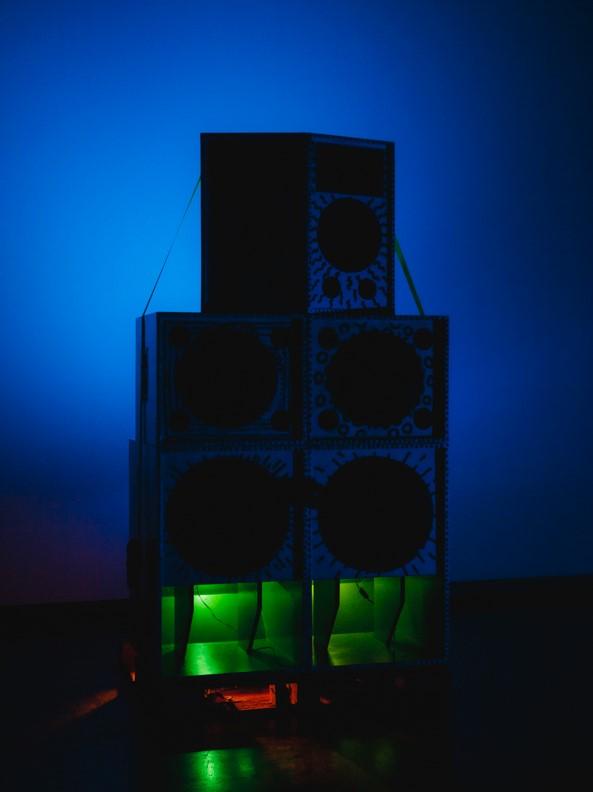
Custom built speaker by Simon Fuh
The Beginning x TPWParty with DJs fuhsta, Valeroo, and Ace Dillinger,
August 17 2024, Gallery TPW (Toronto),
Photo credit: Gloria Wong.
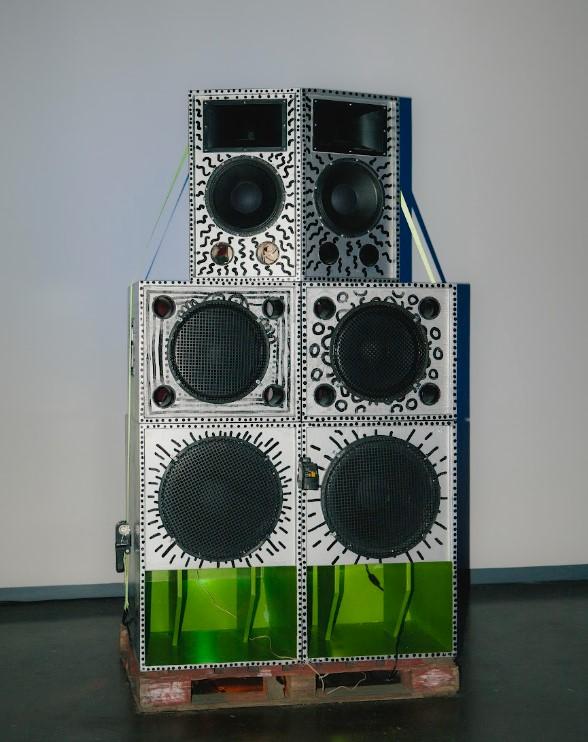
Custom built speaker by Simon Fuh
The Beginning x TPWParty with DJs fuhsta, Valeroo, and Ace Dillinger,
August 17 2024, Gallery TPW (Toronto),
Photo credit: Gloria Wong.
But when the parties ended, the move to Toronto, the isolation of the pandemic, and the reflection on those experiences became the backdrop against which you researched and developed Memory Theatre. That work references parties as spaces of memory, culture, and connectedness.
Yes, but with Memory Theatre, I'm representing the social surroundings or the social conditions of a potential party that you can only hear outside of. There’s a play with frames that happens in the work. You experience the work in the frame of a gallery and you can conceptualize a party, which is then itself another social frame, but that party is happening in an inaccessible place, inside the wall and spatially behind the person who you're hearing on the phone. So even in the exhibition, the party and the artwork are also distinct.
When I experienced that work, it provided a container for my slippery memories to hold still alongside my lack of remembering. It reminded me that I once saw an entry on a writers forum that stated “Anything less than 100% true is fiction” —which left me wondering if everything I thought I remembered was a fabrication. My memory is imprecise at best, and this is especially true of my party memories.
Twenty years ago, there was a basement club less than a block away from where we work now. To historicize, the first time I saw someone take a photo with their phone was in that club. I spent a lot of weekends there getting high and dancing to house music. I can’t recall the interior architecture of the room, nor the name of the resident DJs. I do have other distinct, embodied memories, like the euphoric feelings of my breath moving in rhythm to the low end sound, or how the music dampened to be met by chatter in the smoky din of the ever-social bathroom.
With Memory Theatre, I had the realization that in the absence of precise memory, you’re left to do your own recreation, or to piece together the descriptive memories of others who were there with you. In that state of semi-fiction, holding truth feels unreachable, unreliable, un-recreatable.
I know that you’re interested in writing microhistories and experimenting with historical fiction and auto fiction. I'm curious what you think of this claim that anything other than 100% truth is fiction.
There’s different kinds of truths and fictions. The truth of the courtroom, or the facts of science, for example, versus more qualitative claims like “that event was significant,” or “I am this or that type of person,” which are totally subject to fictionalizing. I’m not really concerned with factuality in my work, even if I begin with true stories. I like the feeling of slipping in and out of fact.
I learned recently that in the process of memory, there's no place in your brain where memory is stored like a hard drive. The act of remembering is much more like the act of imagining. So every time you remember something, you’re recreating it, you're rewriting that memory. You're redrawing what it looks like in your head every single time. So even our own recollections are far from objective.
In that sense, collective nostalgia also becomes mythical reconstruction. Social memory, and remembering together are themselves creative practices. When I talk about those old Literally Underground parties with other people, we’re rewriting those memories together, altering or reinforcing collective mythologies.
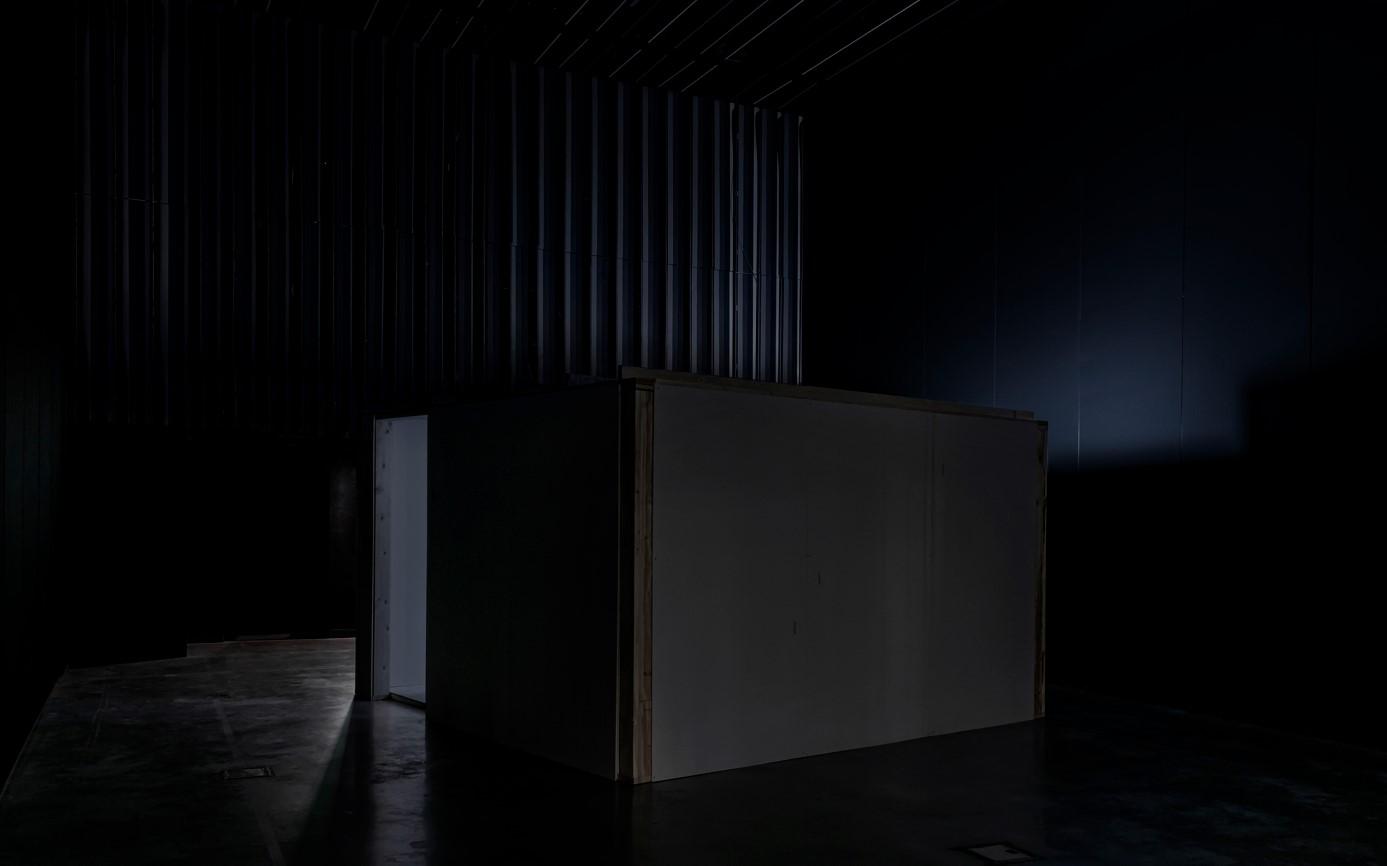
Simon Fuh, Memory Theatre (2021) installation view.
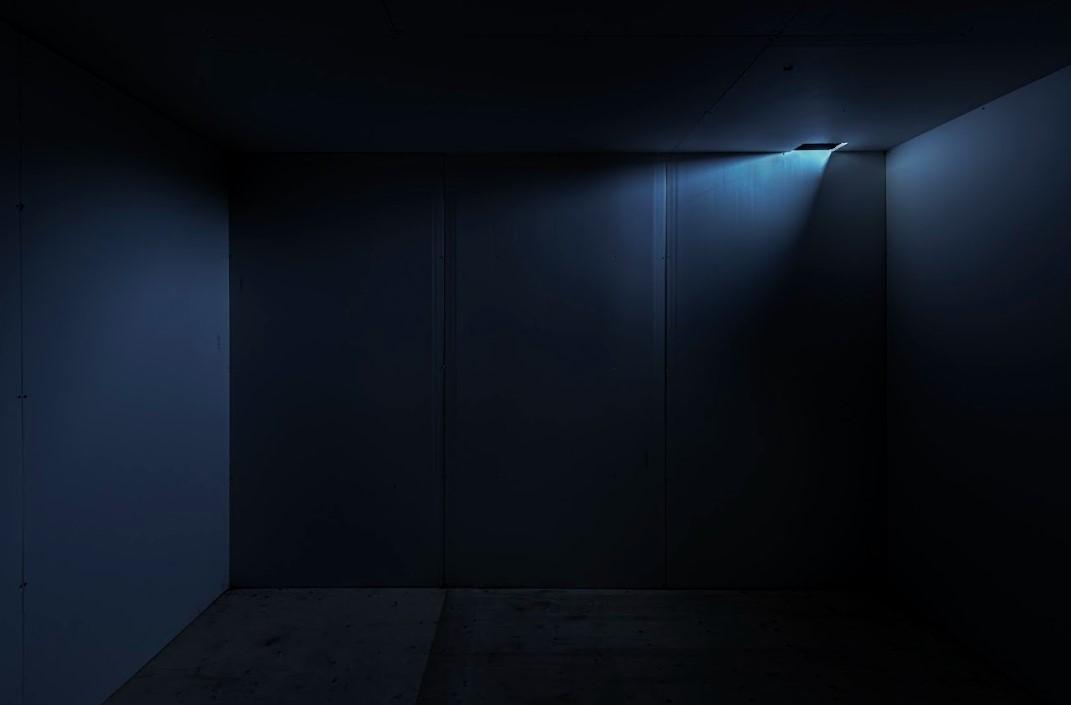
Simon Fuh, Memory Theatre (2021) installation view.
I've been thinking through the question of what it is we desire when we feel the urge to attend or throw parties. What is the alchemy that we’re chasing?
There’s a few people writing about this, like McKenzie Wark2 and Brandon Labelle3, and I’ll put you in this category of party-writers too, given your artist book, For Now You Had To Be There, which includes personal essays that reflect on the Literally Underground parties.
Labelle has this theory that a party pushes towards a certain social dis-organization, that “a party is always moving towards excess … to party is to work at wreckage.”5 By that I think he means something more than just a cursory idea of hedonism and self-destruction, but a state of wreckage that is more intentional, more collective. He refers to the party as providing “a deeply experimental scene for rehearsing society’s reinvention, supporting an art of revolt.”6 So he offers the idea that some other way of being can emerge from the wreckage, which we rehearse in the heightened social space of the party.
This made me think about your recent work, Greenlight: Carlaw, which writes a piece of micro-historical fiction from a local viral video.
Yes, so the work originates from a tweet by realtor Desmond Brown which documented a group of teens caught squatting in a vacant house for sale in Toronto. He posted a video that depicts a bunch of kids running out of the empty house as he scolds them for being there. Evidently they’d spent the night and were surprised by him walking in to show the house the next morning.
You take the video as a starting point but respond in an explicitly fictional way. The imagined character of an anonymous basement tenant witnesses something audibly from a position that is timely and specific to the Toronto experience now—through the lens of precarity, and the impending loss of one’s home.
For me, Greenlight: Carlaw resonates with Labelle’s idea of the generative power of the party as an act social undoing because of what those kids were up to and because of the tensions you’ve written—foregrounding political ideas, but bumping them up against the soft and nostalgic feelings of coming-of-age. Sure, they’re being rebellious and defiant, but not with the intention of laying bare the problematics of disparity in the housing economy. Would you qualify their party as an act of social dis-organizing?
Totally. The situation they’ve created—breaking into a house that is meant to be emptied and objectified, sanctioned as not-to-be-lived-in, is an undoing of trivial social norms. But in the scripted audio play, there are six characters, just talking about their lives, for the most part making jokes and talking about their anxieties. Because it's happening in the shadow of this kind of social undoing, there’s a spectre of larger things happening, and I like that idea. Sort of like having a heart-to-heart while you're vandalizing a wall. There are still moments of sweetness and intimacy. But you’re also remaking the world in a way that you need to.
In a way that is soft, but also disruptive.
Yes, a quick way to undo the norms of social life is to do something illegal. Maybe that’s what’s drawing us, and these other writers you mentioned, to think through a certain type of party—the ones with a bit of danger. Parties that introduce a new set of rules or completely subvert the existing set of rules.
What was enticing about these kids' situation was that they undid those rules for that night. Still, they were just a group of people who could live out their regular conversations while undoing the social norms because they happened to be doing something illegal. The best parties are like this. Even if a party is big and impressive, when it’s sanctioned and doesn’t break any norms it becomes unmemorable.
And memory plays a key role in how we narrativize our own identities. I don’t say identity in the way it's commonly used in art parlance, by the way. I mean identity as in the collection of events and self-defined mythologies that make up how we imagine ourselves in a present moment—this very unstable fiction of “me, now.” Our memories are always re-analyzed and reframed by the desires of our present selves, which means that the things that once happened to you are constantly being rewritten to serve the current narratives we have about ourselves in the present. Those narratives may or may not be “true.”
For example, say I experience a sudden shift in my desires that make me want to become a lawyer instead of an artist. All of those past events about parties that I talked about earlier might start to look a lot different to me now, because I want to reshape my idea of myself to fit this current, more professional, identity. And also, the actual lived experience of being around me exists in the memories of other people, not my own. From this perspective, I don’t actually have that much access to who I “am” because it exists in the myriad of ongoing fictions within the minds of people around me. We live in a culture of extreme belief in the solidity of “identity,” which helps people brand and commodify themselves. I’m a lot more interested in how slippery, changing, and socially defined the self is.

Simon Fuh, from the series DRIVER, 2024

Simon Fuh, from the series DRIVER, 2024
You're developing a new body of work that weaves together many threads of this conversation, especially formative moments of youth and how experience forms identity. Earlier this year, you travelled to Taiwan, where your father lives. You revisited two trips, travelling again to places where you experienced familial loss but also coming-of-age and self-exploration. You've shared with me a portfolio of images that emerged from that trip, and I see that this project links your interests in writing and photography in ways you didn't necessarily expect when you set out to go back there.
Yeah, I’m developing a body of work about returning to a place that was connected to a death in the family. But when I got there, I realized the place didn’t haunt me the way it used to, and in fact I was much more saddened by the peripheral locations where I spent my early twenties (a few years after this death). I keep saying that I went to Taiwan to mourn my mother, and ended up mourning my youth. So I’ve ended up engaging with the idea more playfully.
I’ve been making drawings on the photographs, and have been very specific about the narrative quality of seeing them in relation to others in the series. I think that act is more writerly than it is photographic. I'm taking, for lack of a better word, “snapshots,” but forming them as small sentences that together mean something larger.
So, these photographs start to form a narrative in their seriality, and the added element of drawing makes them read more playfully. The gesture of adding drawing to a photograph conjures an idea of writing it differently.
Yes, and I don’t draw on all of them, I’m choosing to draw on certain images and not others mostly for aesthetic qualities. Not to omit or redact things, but rather to create a mood, for example, adding imagery from childhood, as a way to write an overall tone to a body of work.
Perhaps, making visible the spectres of larger things happening.
Yes. Thinking back to how a memory is recreated every time you remember it; this must be a fact about neurology that I think is easier for writers to understand than it is for photographers to understand. As a writer, when you re-summon memories, you know you are rewriting them. A creative and intuitive process is built in, and a writer may be more comfortable with the fact that they're fictionalizing or that the story of a memory is partly fiction. Whereas in photography, there is a simulation of an archive or a simulation of an objective reality. Light literally touched this object. Even though a photograph presents only a single perspective, and there are many ways to interpret an image, it still gives a facade of trueness.
Hm, what’s true is that moments are recorded with intention—but the piece around photography that’s framed as holding time, to me, is fictional. I’d rather think about ways that an image can be activated, in and out of its time, where its truths are less fixed.
Are you considering adding a written element to narrativize these works more literally?
I’ve been journaling alongside the project, but trying to avoid discursive framing of the project. I want to let go of an anxiety where I need the work to be interpreted in a certain way.
Is that an undoing of your graduate degree? The behaviours of academic environments carry into art presentation spaces and I think we're at a moment to break that mould. Not necessarily because it makes artworks inaccessible but it frames looking in prescriptive ways, which takes away from the agency of experience.
Yeah, of other people’s experience.
And of the artist.
That’s true too. And it doesn’t let the work live on its own terms. People are smart, and capable of reading cultural objects.
Yeah, I believe there is a certain level of visual literacy, for lack of a better, fully-sensorial term, that comes from being a person in the world. And I am someone who loves reading and has a practice that is about research, but it's really just about reading alongside being in the world.
You can be told so many times that research is more than just reading, but that’s never really true as a grad student because you only have time for reading. Coming out of that environment and having language now that gives a sense of validity to the things you do outside a classroom or reading is really nice.
You and I have spoken recently about the role of social spaces in Toronto's arts community. Openings, often in smaller DIY spaces, generate more buzz and conversation than the artworks. After losing stalwart publications like Canadian Art, we lack journalistic sources for art news, and gossip fills that gap. Many conversations amongst artists and cultural workers revolve around distrust in artistic institutions—a warranted distrust given the heightened censorship and job insecurity that has shown its face pretty brazenly this year. Coupled with the affordability crisis in Toronto, the city has become inhospitable to artists, which feels more palpable than ever. This isn't a new conversation, but a renewed sense of urgency exists around it.
As an artist and an aesthete, how might you translate this moment?
From the perspective of an artist, I’m compelled to just say the AGO is no longer an art gallery. This is the institution that people believe in the least. I just thought one day, the Art Gallery of Ontario fires and silences all of their creative staff and is run by managers. Is it possible that their social frame has become so weak that it’s literally not an art gallery anymore? I keep bringing this up, but I don’t really know what to do with the thought. Is this even a question of consequence? Does everyone already know that the AGO isn’t even an art gallery?
I think artists have a lot more soft power than people realize to slowly change the perception of institutions. We’ve generally offloaded the definition of “what art is” to institutions, which is to say that whatever is in (certain) art galleries is art.
The thing I keep coming back to is the question of who do they serve? There is a very active boycott of the AGO happening but it doesn’t seem to prevent them from doing their business. They’ll always have a built-in audience beyond those who know and are tapped into the specific and very live politics happening within the art world, which is insular and rife with scarcity to begin with.
And they aren’t serving artists. I think artists have a lot more soft power than people realize to slowly change the perception of institutions. We’ve generally offloaded the definition of “what art is” to institutions, which is to say that whatever is in (certain) art galleries is art. But, for me, KAWS isn’t just bad art, it’s not art. And a gallery that fires and silences Indigenous curators for having political beliefs isn’t capable of bestowing legitimacy. So the AGO isn’t an art gallery. It’s more like a conference centre with an art collection.
It comes back to the question of how people perceive artworks. Artworks have a specific framing in the context of institutions. We can benchmark the AGO as the most institutional framework in our immediate vicinity. And yet, there are so many different, varying degrees of institutional spaces—for example, artist-run centres frame things differently but still have institutional histories, organizational practices, and corporate ways of being. DIY spaces work in response to that and try to forge new models that frame things differently again.
But that applies such an insider perspective on people's experiences with contemporary art. To me, a more critical question is how much of an artwork's experience is inherent to its being.
Hm, yeah, in a way those big institutions are where artworks go to die. In the same way that an institutional framing kills a party, an institutional framing is intentionally designed to suspend an object apart from the conditions that made it. And those conditions that made it, to you and me, might be much more interesting.
To be an aesthete—kind of a cheesy word but useful in the sense that it implies a doing, or a consumptiveness—is to be active. But to frame art as that which lives in the institutions, is to make it static and dead. To objectify it, literally. For most people, the most enriching experiences we have are the ones that happen in relation to doing. That’s not to say that you can’t have life changing experiences with those static objects, it just means galleries have a responsibility to the people coming through their doors.
At least artist-run centres have active communities, and generally care about art and ideas. An opening at the AGO is completely alienating, a bunch of atomized people in this bureaucratic space that treats them like inconvenient children. All the AGO wants is for these strangers to buy tickets and then go away. Management doesn’t care about the art experience or social meaning because that would introduce friction and critical thought, which could involve conflict that they’re not capable of facilitating.
I wouldn’t say that the same dynamic of an art gallery killing objects exists at all institutions. It’s definitely a gradient, and as we know, these other levels of institutions are so important in facilitating a social life.
I agree, there’s a liveness that happens in more informal spaces in a way that foregrounds relationality, which takes up the work of organizing more so than undoing.
In that sense, you’re coming to a more granola idea of organizing community. You’re pro-granola. But still, a much better alternative than loneliness.